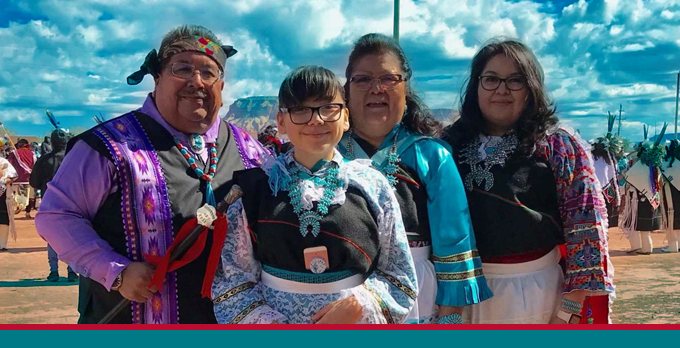 How many steps do you take in a day? For many people reaching the ideal 10,000 steps is a challenge, but not for Valda Arguello—she’s an emergency room nurse.
How many steps do you take in a day? For many people reaching the ideal 10,000 steps is a challenge, but not for Valda Arguello—she’s an emergency room nurse.
“It’s kind of this competition with my husband who is a correctional officer” Arguello, RN, said laughing. “I'm like, ‘hey, guess what I did- 16,000 steps today.’”
She usually wins.
Arguello works at The University of New Mexico Sandoval Regional Medical Center – A Campus of UNM Hospital (SRMC). She is Native American, something that is not only meaningful for her, but for her patients as well.
“I am a member of the Zuni Pueblo,” Arguello said. “I'm full Native American, full Zuni. I grew up on the reservation in Zuni until I was 19 years-old and then I moved to Albuquerque. My dad has always been involved in Tribal politics, so I've always been busy embedding myself within the community.”
Zuni Pueblo
- Located about 150 miles west of Albuquerque
- Main reservation located in McKinley and Cibola counties (additional land in Catron County and Apache County in Arizona)
- Encompasses about 450,000 acres
- At about 1,300 years, Zuni is one of the oldest continuously inhabited settlements in North America.

Arguello is a PRN, or freelance employee, at SRMC. Her full-time job is a Pueblo case manager at Santo Domingo Health Center. She said she knew she wanted to be a nurse at a young age but wasn’t sure where she wanted to focus.
“I started working as an ER tech when I was 19 and I said, ‘I think this is it. This is my thing.’”
Arguello said she had great friends who encouraged her to continue school and pursue nursing.
“So, I did it, and it's absolutely my thing,” she said.
As a Native American, Arguello said being present in the ER at SRMC is incredibly important for her community. She can communicate and care for Native American patients in a way that is both meaningful and honoring to cultural and spiritual beliefs.
“It's a different kind of a bond that our people have,” Arguello said. “If I run into somebody that's in the emergency room who is Native, it's really interesting how they kind of gravitate towards me. And if I'm their nurse, they get so happy.”
That bond helps ease a tense and uncomfortable environment.
“They'll start saying, ‘where are you from?’ That's always the favorite question, ‘where are you from? Who are your parents?’ It makes it a good experience for them because I’m Native.”
As a Level-III trauma center in Sandoval County, SRMC sees many patients from surrounding rural and Tribal communities. Arguello said a big part of her role is to be an advocate.
“In the emergency room, we do get a lot of people from the surrounding Pueblos, and when they come in, sometimes even the difficult patients are a little easier for me to settle down because sometimes I can talk to them in their language.”
Knowing the language and the culture can make all the difference—especially in an ER. Arguello works with both patients and the SRMC team to navigate cultural differences.
“There's a lot of cultural misinterpretations,” Arguello said. “With Native Americans, there’s not a lot of eye contact. Some Native women don't like to undress when that's one of the things we have to do in the ER; we have to look at everything. So, I explain to them it's ok- you’re ok.”
Native Americans have a rich history with UNM Hospital and SRMC. For both hospitals, expanding health care access to Tribal communities while being culturally respective is a top priority. Arguello said it’s one of the reasons she chose to work at SRMC.
“I've always been appreciative of that,” she said. “I think that's why a lot of our Native population choose to go to SRMC if they have to go to a hospital or to the emergency room.”
“I’ve been a patient at SRMC, and I was absolutely taken aback by the care I received in the ER. It was absolutely amazing. Everyone was so kind,” she said. “I've worked in several different health systems, and UNM has been by far, one of the greatest hospitals, because they treat people like humans. There’s never any judgement”
Click here to find out more about Native American health services within the UNM Health System and more about the long-standing commitment between UNM Hospital and the Native American community in New Mexico.
